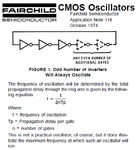exp
Full Member level 1
Hi,
A ring oscillator requires 3 inverters. According to Wikipedia, each stage has 120 degree phase shift, making up 360 degrees.
But why 120 degree? If I just plot -1/(1+s^2), the frequency at which 120 degree occur is -6dB. Why this value and not anything else?
Also, one could regarding one inverter as +180 degree, followed by a 1st order RC, which would total in +90 degree. Why is this invalid?
Assuming an ideal inverter with infinite bandwidth (inversion appears in zero time at output), shouldn't 2 inverters (which commonly make up a latch) oscillate? Each inverter would have +180 degree pure shift, making a total of 360 degree.
A ring oscillator requires 3 inverters. According to Wikipedia, each stage has 120 degree phase shift, making up 360 degrees.
But why 120 degree? If I just plot -1/(1+s^2), the frequency at which 120 degree occur is -6dB. Why this value and not anything else?
Also, one could regarding one inverter as +180 degree, followed by a 1st order RC, which would total in +90 degree. Why is this invalid?
Assuming an ideal inverter with infinite bandwidth (inversion appears in zero time at output), shouldn't 2 inverters (which commonly make up a latch) oscillate? Each inverter would have +180 degree pure shift, making a total of 360 degree.
